A late report on observations from December 18. The grant committee hearing last Thursday took too much of my time and energy to report earlier to this log.
This were the first observations being back on-line and tracking with a new laptop ("Elvis") after a fatal crash of my old laptop ("HAL") the 12th. Conditions were poor: hazy. No pretty pictures this time...
I observed Lacrosse 3 and the Lacrosse 5 Rocket (05-016B). The Lacrosse 3 (97-064A) was trail very marginal on the image. I dropped a second trail image on 97-064A obtained during its next pass as it was even more marginal. My two points on the first trail come out a few tenths of seconds different from those of other observations around this time.
By contrast, the Lacrosse 5 Rocket (05-016B) trail was of good quality and agreed well with other observations obtained around that time. 05-016B was 4.6s early and 0.11 degrees off-track with regard to an 8 day old elset; 97-064A some 0.9s early and on-track with regard to similar aged elset.
A female neighbour came by for a chat when seeing me photograph and watched 05-016B passing over Polaris with me.
THE SECRET SPIES IN THE SKY - Imagery, Data Analysis, and Discussions relating to Military Space
SatTrackCam Leiden (Cospar 4353) is a satellite tracking station located at Leiden, the Netherlands. The tracking focus is on classified objects - i.e. "spy satellites". With a camera, accurate positional measurements on satellites of interest are obtained in order to determine their orbits. Orbital behaviour is analysed.
This blog analyses Missile tests too.
Sunday 24 December 2006
Friday 15 December 2006
SatTrackCam temporarily down
SatTrackCam has been temporarily down the past week and will be for a few more days. The reason is that my old faithful lap-top HAL died last Tuesday.
I have a new lap-top since late this afternoon. I need a few more days however to configure it, re-install software etcetera. Moreover, I have to be at a committee hearing of our National Science Foundation coming Friday in connection to my Post-Doc proposal and have to prepare for that. So I think it will not be before Christmas before I am fully up and running again.
I have a new lap-top since late this afternoon. I need a few more days however to configure it, re-install software etcetera. Moreover, I have to be at a committee hearing of our National Science Foundation coming Friday in connection to my Post-Doc proposal and have to prepare for that. So I think it will not be before Christmas before I am fully up and running again.
Sunday 10 December 2006
Lacrosse 2 & Lacrosse 5 Rocket in hazy skies
Unlike the clear skies of this morning (see previous post), it was quite hazy this evening. Images were considerably fogged as a result - no pretty pictures.
Targets were Lacrosse 2 (91-017A, #211147) and the Lacrosse 5 Rocket stage (05-016b, #28647). Got two images on each object. The trail of 91-017A on the first image was very marginal. 05-016B was nice and bright, I saw it go into eclips near the end of the last exposure. Both objects crossed Pegasus and then Andromeda/Aries, 20 minutes apart in time.
05-016B was some 6.4 to 6.5s early and some 0.15 degree off-track relative to 6 day old elset 06339.03434948. 91-017A was nicely on-time and on-track.
Targets were Lacrosse 2 (91-017A, #211147) and the Lacrosse 5 Rocket stage (05-016b, #28647). Got two images on each object. The trail of 91-017A on the first image was very marginal. 05-016B was nice and bright, I saw it go into eclips near the end of the last exposure. Both objects crossed Pegasus and then Andromeda/Aries, 20 minutes apart in time.
05-016B was some 6.4 to 6.5s early and some 0.15 degree off-track relative to 6 day old elset 06339.03434948. 91-017A was nicely on-time and on-track.
Lacrosse 5 & its "disappearance trick" again
I observed Lacrosse 5 (05-016A, 28646) this morning, and timed it's "disappearing trick" again.
I saw it emerge out of earth shadow above alpha Auriga at a bright mag. +1 at about 5:19:00 UTC. It then crossed towards Umi, over Polaris, bright and steady. At 5:21:24 ± 1s UTC at 45 deg altitude in the N-NE it did its trick again, fading from mag. +1.5 to naked eye invisibility in just a few seconds.
05-016A was nicely on-time and on-track. I obtained 3 images, hence 6 positions.
I was up in the middle of the night too, to watch the Shuttle launch on NASA-TV at 2:47 am local time.
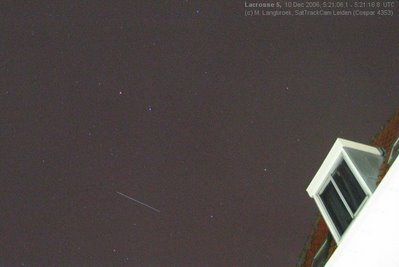
I saw it emerge out of earth shadow above alpha Auriga at a bright mag. +1 at about 5:19:00 UTC. It then crossed towards Umi, over Polaris, bright and steady. At 5:21:24 ± 1s UTC at 45 deg altitude in the N-NE it did its trick again, fading from mag. +1.5 to naked eye invisibility in just a few seconds.
05-016A was nicely on-time and on-track. I obtained 3 images, hence 6 positions.
I was up in the middle of the night too, to watch the Shuttle launch on NASA-TV at 2:47 am local time.
(click image to enlarge)

Thursday 7 December 2006
Shuttle STS-116
Pre-flight orbital elements for the upcoming Space Shuttle Discovery STS-116 flight came available on the NASA Spaceflight website yesterday.
A quick check yesterday evening revealed to me that, alas, the flight will not be visible for me: all night-time passes (before docking and after undocking) will take place while the Shuttle is in eclipse. So, 'll have to be content with just watching the launch on NASA-TV.
A quick check yesterday evening revealed to me that, alas, the flight will not be visible for me: all night-time passes (before docking and after undocking) will take place while the Shuttle is in eclipse. So, 'll have to be content with just watching the launch on NASA-TV.
Wednesday 29 November 2006
UARS impostering as ISS, the real ISS, Lacrosses and a rocket stage
This morning was very fine. I obtained 15 positions on 5 objects: Lacrosse 2 (91-017A), Lacrosse 3 (97-064A), UARS (91-063B), an old Russian Soyuz rocket stage (70-037B), and the International Space Station, which made a fine pass again.
And I almost got fooled by a celestial imposter!
At the end of the fine pre-dawn session I was waiting for a pass of the ISS. While preparing the camera I realised I had used elements from before the scheduled orbit boost for ISS, so I reckoned it might perhaps appear somewhat off-time (later, it turned out I made a mistake in this anyway, as the boost would only occur his evening and not last evening as I thought by mistake...).
At 5:42 UTC, 1 minute early, I saw a bright object appear in Gemini close to but slightly south of the point where ISS should emerge from earth shadow. It initially was about mag. +0.5 in brightness. "Ah, there it is!" I thought and triggered the camera...

As the camera ended its exposure, I realized something was wrong...
My brain registered disappointment about the brightness of this "ISS", then wondered about a 1 minute early appearance (a bit too much??), and as I watched the object I realized its course was bringing it much too much north to be ISS...so, this was an imposter!
So I quickly swapped back the camera. And yes, there it appeared,low west, almost at te moment I turned my sight to it: the real ISS, close to Castor and Pollux, at a splendid bright mag. -3...!

The "imposter" was later identified as te Upper atmospheric research satellite UARS (91-063B, #21701). The darn thing almost fooled me...! :-P
Like from my images of last Friday, I constructed a mozaic of two ISS trail images from this morning again:

It is well visible how bright ISS is just after coming out of earth shadow.
Apart from ISS and UARS, I also imaged Lacrosses 2 & 3 this morning, and recorded a second stray on one of the Lacrosse 2 images, which turned out to be 70-037B (#04394), an old Russian Soyuz rocket stage from the Meteor 1-4 launch, 1970.
And I almost got fooled by a celestial imposter!
At the end of the fine pre-dawn session I was waiting for a pass of the ISS. While preparing the camera I realised I had used elements from before the scheduled orbit boost for ISS, so I reckoned it might perhaps appear somewhat off-time (later, it turned out I made a mistake in this anyway, as the boost would only occur his evening and not last evening as I thought by mistake...).
At 5:42 UTC, 1 minute early, I saw a bright object appear in Gemini close to but slightly south of the point where ISS should emerge from earth shadow. It initially was about mag. +0.5 in brightness. "Ah, there it is!" I thought and triggered the camera...
(click image to enlarge)
As the camera ended its exposure, I realized something was wrong...
My brain registered disappointment about the brightness of this "ISS", then wondered about a 1 minute early appearance (a bit too much??), and as I watched the object I realized its course was bringing it much too much north to be ISS...so, this was an imposter!
So I quickly swapped back the camera. And yes, there it appeared,low west, almost at te moment I turned my sight to it: the real ISS, close to Castor and Pollux, at a splendid bright mag. -3...!
(click image to enlarge)
The "imposter" was later identified as te Upper atmospheric research satellite UARS (91-063B, #21701). The darn thing almost fooled me...! :-P
Like from my images of last Friday, I constructed a mozaic of two ISS trail images from this morning again:

(click image to enlarge)
It is well visible how bright ISS is just after coming out of earth shadow.
Apart from ISS and UARS, I also imaged Lacrosses 2 & 3 this morning, and recorded a second stray on one of the Lacrosse 2 images, which turned out to be 70-037B (#04394), an old Russian Soyuz rocket stage from the Meteor 1-4 launch, 1970.
Tuesday 28 November 2006
Satellites, ISS and an Asteroid
This morning was another clear and still morning. A bit of haze and a small patch of thin clouds every now and then. Like the previous morning, I observed Lacrosse 2 & 3 (91-017A & 97-064A) and a zenith pass of the International Space Station. I obtained 2 images and thus 4 points on each object.
97-064A and 91-017A (Lacrosses 3 & 2) appeared some 10 minutes after each other in the same sky area with almost the same sky elevations, range and illumination phase. This made me appreciate the somewhat different intrinsic brightness between the two (Lacrosse 3 seems a bit fainter), which was clear visually and to some extend also on the photographs.
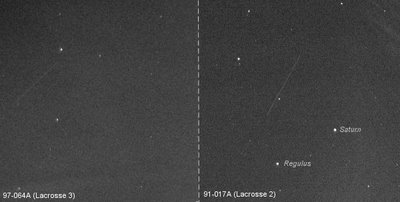
ISS was nice and bright at about mag. -2 when emerging out of shadow crossing the legs of Ursa Major near the zenith (see image below), yet not as bright as last Friday.
Meanwhile, todays' DOU in MPEC 2006-W103 contained the publication of my latest asteroid discovery, 2002 BF32 (packed: K02B32F). It is a 1 km large (H17.6) MB II main belt asteroid which I discovered in NEAT archive images from January 2002 last week. It has perihelion at 2.1 A, aphelion at 3.1 AU and an orbital inclination of 12 degrees. The orbital arc is short, I managed to track it over only 3 nights.
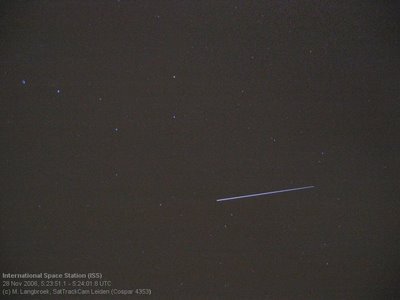
97-064A and 91-017A (Lacrosses 3 & 2) appeared some 10 minutes after each other in the same sky area with almost the same sky elevations, range and illumination phase. This made me appreciate the somewhat different intrinsic brightness between the two (Lacrosse 3 seems a bit fainter), which was clear visually and to some extend also on the photographs.
(click image to enlarge)

ISS was nice and bright at about mag. -2 when emerging out of shadow crossing the legs of Ursa Major near the zenith (see image below), yet not as bright as last Friday.
Meanwhile, todays' DOU in MPEC 2006-W103 contained the publication of my latest asteroid discovery, 2002 BF32 (packed: K02B32F). It is a 1 km large (H17.6) MB II main belt asteroid which I discovered in NEAT archive images from January 2002 last week. It has perihelion at 2.1 A, aphelion at 3.1 AU and an orbital inclination of 12 degrees. The orbital arc is short, I managed to track it over only 3 nights.
(click image to enlarge)

Monday 27 November 2006
Lacrosses and ISS
Another clear morning, albeit slightly hazy. Targets were Lacrosse 2 (91-017A, #21147), Lacrosse 3 (97-064A, #25017) and the International Space Station.
The ISS was less bright than last Friday, at about mag. -1.5 shortly after exiting shadow in Canes Venatici. It was "white" this time. The positional residues are nice:
STA___YYday_HH:MM:SS.sss___XTRK____deltaT____Perr
4353__06331_05:04:31.100__-0.00_____0.09_____0.054
4353__06331_05:04:41.800___0.00_____0.01_____0.008
Lacrosse 2 (91-017A) was bright (mag. +2) as it came out of shadow and traversed the tail of Ursa Major. I obtaned 1 picture, 2 points. It was 0.4s late and 0.2 degrees off-track relative to an 8-day old elset.
Lacrosse 3 (97-064A) was fainter (mag. +3.0 to +3.5). I obtained 2 images, hence 4 points. was 1 second late but on-track relative to an 8-day-old elset.

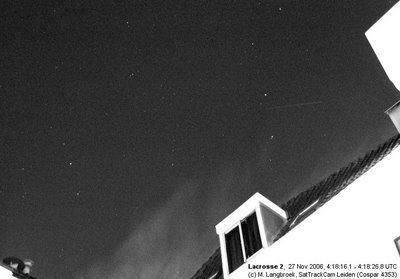
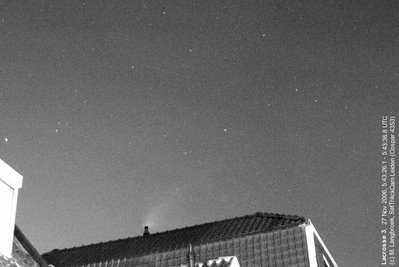
The ISS was less bright than last Friday, at about mag. -1.5 shortly after exiting shadow in Canes Venatici. It was "white" this time. The positional residues are nice:
STA___YYday_HH:MM:SS.sss___XTRK____deltaT____Perr
4353__06331_05:04:31.100__-0.00_____0.09_____0.054
4353__06331_05:04:41.800___0.00_____0.01_____0.008
Lacrosse 2 (91-017A) was bright (mag. +2) as it came out of shadow and traversed the tail of Ursa Major. I obtaned 1 picture, 2 points. It was 0.4s late and 0.2 degrees off-track relative to an 8-day old elset.
Lacrosse 3 (97-064A) was fainter (mag. +3.0 to +3.5). I obtained 2 images, hence 4 points. was 1 second late but on-track relative to an 8-day-old elset.
(Click images to enlarge)



Friday 24 November 2006
A Lacrosse, a Lacrosse rocket and the ISS (updated)


(Click images to enlarge)
I was up early this morning. The sky had cleared, although streaks of fast-moving clouds still wandered across the sky.
First target was Lacrosse 3 (97-064A,# 25017) around 5:17 local time (4:17 UTC). It was faint, the trail on the photograph was rather marginal. My results suggest it was 0.15 seconds late and 0.1 degree off-track relative to a 5-day old elset, but as the trail was very marginal, don't pin me down on it.
Next target was the Lacrosse 5 Rk rocket stage (05-016B, #28647). While traversing from Auriga into Gemini around 5:57 local time it was quite bright, magnitude +1. Once in Leo at 5:58 local time, it had faded to mag +3.5. Got 2 photographs and hence 4 positions, but the last one dropped because it came out clearly erratic. The other three points more or less agree, and suggest it was on-time and on-track.
Highlight of the night was a fine pass of the International Space Station at 6:37 local time (5:37 UTC), see the two pictures above. When it came into view at about 35 degrees altitude, close to Procyon, it already was well into the negative magnitudes, about magnitude -3 I estimate. It stayed that bright while crossing the body of Leo and passing close to Saturn at about 55 degrees altitude: it dimmed when going towards the eastern horizon. It had a somewhat orange colour again.
I have seen ISS this bright before, but that was during zenith passes. I wonder what brightness it currently could attain in the zenith. Hope to be able to check that out soon, as ISS starts to make more favourable morning passes.
UPDATE: I've combined the two ISS pass photographs into one composite image
(click image to enlarge)

Monday 20 November 2006
Lacrosse 4 results (update)
My observations of yesterday (last two lines, in bold, station 4353) compared to elset 06323.75609492 and a few other station's data for Nov. 16-19, 2006. X-track and positional error in degrees, delta T in seconds. As I said: nice residuals.
Lacrosse 4
1 26473U 00047A 06323.75609492 0.00000140 00000-0 26459-4 0 07
2 26473 67.9958 184.9503 0005500 264.0178 95.9822 14.64305775 03
STA YYday HH:MM:SS.sss____XTRK deltaT Perr
2420 06320 16:51:34.620__-0.01__0.07 0.020
2675 06320 18:30:25.860__-0.02_-0.20 0.040
2675 06320 18:32:29.700__-0.04_-0.27 0.122
2675 06320 18:33:01.760__-0.02_-0.03 0.023
2751 06322 18:04:36.150___0.01_-0.05 0.024
2751 06322 18:04:42.260__-0.01_-0.05 0.019
2751 06322 18:05:56.050__-0.04_-0.14 0.076
2675 06322 19:44:55.430___0.05_-0.01 0.049
2675 06322 19:45:37.100___0.06_-0.03 0.062
4353 06323 18:41:51.100___0.05__0.01 0.045
4353 06323 18:42:01.800___0.08__0.05 0.081
rms 0.05949
Lacrosse 4
1 26473U 00047A 06323.75609492 0.00000140 00000-0 26459-4 0 07
2 26473 67.9958 184.9503 0005500 264.0178 95.9822 14.64305775 03
STA YYday HH:MM:SS.sss____XTRK deltaT Perr
2420 06320 16:51:34.620__-0.01__0.07 0.020
2675 06320 18:30:25.860__-0.02_-0.20 0.040
2675 06320 18:32:29.700__-0.04_-0.27 0.122
2675 06320 18:33:01.760__-0.02_-0.03 0.023
2751 06322 18:04:36.150___0.01_-0.05 0.024
2751 06322 18:04:42.260__-0.01_-0.05 0.019
2751 06322 18:05:56.050__-0.04_-0.14 0.076
2675 06322 19:44:55.430___0.05_-0.01 0.049
2675 06322 19:45:37.100___0.06_-0.03 0.062
4353 06323 18:41:51.100___0.05__0.01 0.045
4353 06323 18:42:01.800___0.08__0.05 0.081
rms 0.05949
Sunday 19 November 2006
Lacrosse 4 lucky shot
Date 06323.78 - The past days has seen the same frustrating pattern: either a fully clouded day, or a day with clear skies in daytime and midnight, but clouds in the evening and morning.
This evening however, I made a very lucky shot of Lacrosse 4 (00-047A, #26473) as it traversed Lyra at 40 degrees altitude in the west. There was a gap in the clouds, I stood on the courtyard, waiting with my DCF clock in hand and camera ready, watching the clouds move in again, muttering to myself and the Lacrosse: "Come on, COME ON...!". Then Lacrosse 4 cleared the roof, I triggered the camera, followed by 10 tense seconds before it opened, another 10 seconds of exposure with the sat running for the clouds, and then a "whew!" from me as the exposure finished just seconds before Lacrosse 4 disappeared in the clouds. A very close call!
Below image shows I am not kidding. This has been a very lucky shot. Obtained 2 points with good residues (the bright star on the image is Vega).
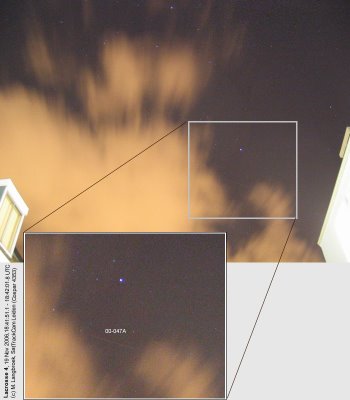
This evening however, I made a very lucky shot of Lacrosse 4 (00-047A, #26473) as it traversed Lyra at 40 degrees altitude in the west. There was a gap in the clouds, I stood on the courtyard, waiting with my DCF clock in hand and camera ready, watching the clouds move in again, muttering to myself and the Lacrosse: "Come on, COME ON...!". Then Lacrosse 4 cleared the roof, I triggered the camera, followed by 10 tense seconds before it opened, another 10 seconds of exposure with the sat running for the clouds, and then a "whew!" from me as the exposure finished just seconds before Lacrosse 4 disappeared in the clouds. A very close call!
Below image shows I am not kidding. This has been a very lucky shot. Obtained 2 points with good residues (the bright star on the image is Vega).
(click image to enlarge)

Monday 13 November 2006
Update on previous post
An update on my previous post: Lacrosse 5 appeared nicely on-time with nice residuals for 3 out of 4 points compared to Mike's elset 06315.73014711:
Date_______UTC________Xtrk__deltaT__Perr
06317__17:55:01.100___0.02___0.15___0.060
06317__17:55:11.800___0.01___0.07___0.034
06317__17:56:01.100___0.03___0.09___0.049
06317__17:56:11.800___0.07___1.59*__0.742*__dropped point
(Values with Scott Campbell's Satfit, X-track and Pos. error in degrees and delta T in seconds)
I dropped the last point because of its obvious anomalous character. This point is not the real end of the trail at the end of the exposure: but the point where the quickly fading satellite dropped in brightness below the imaging sensitivity treshold of the camera, some 1.5 seconds before the end of the exposure.
This underlines the quick fading at that moment: from +1.5 to below the imaging treshold in a mere 10.2 seconds.
Date_______UTC________Xtrk__deltaT__Perr
06317__17:55:01.100___0.02___0.15___0.060
06317__17:55:11.800___0.01___0.07___0.034
06317__17:56:01.100___0.03___0.09___0.049
06317__17:56:11.800___0.07___1.59*__0.742*__dropped point
(Values with Scott Campbell's Satfit, X-track and Pos. error in degrees and delta T in seconds)
I dropped the last point because of its obvious anomalous character. This point is not the real end of the trail at the end of the exposure: but the point where the quickly fading satellite dropped in brightness below the imaging sensitivity treshold of the camera, some 1.5 seconds before the end of the exposure.
This underlines the quick fading at that moment: from +1.5 to below the imaging treshold in a mere 10.2 seconds.
Lacrosse 5 flaring & irregular
Date 06317.75 - After a long period with heavy rain and clouds, the sky cleared this afternoon. Although sky conditions were not perfect (it remained somewhat hazy, hence a bright sky background in the urban environment of SatTrackCam Leiden), it allowed me to observe and image the 17:55 UTC pass of Lacrosse 5 (05-016A, # 28646).

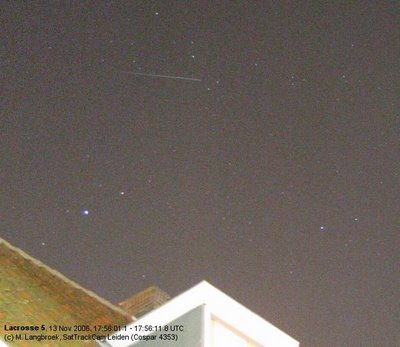
The satellite showed a rather irregular brightness behaviour. While I was setting up my camera it made a short bright flare to mag. 0 low in the west at about 17:53:50 UTC (+/- 10s) lasting only a few seconds. After that it went back to much less brightness (mag +2 to +2.5).
While climbing towards Vulpecula it brightened slowly to mag. +1.5 at 17:55:00 - 17:55:10 UTC. The first of the above pictures captures it during this bright phase.
Next I had to operate the camera, but when looking up at around 17:55:30 it was fainter, about +2.5. Between 17:55:50 and 17:56:10 UTC it brightened again to +1.5 in Vulpecula during a few seconds, then quickly dimmed again and actually went out of visual detection range for me just after 17:56:10 UTC. I captured the peak brightness and fading part on photograph, the rapid fading near the end is apparent in it. See the second picture above (satellite movement is from right to left).
Note that the satellite was nowhere near shadow entry at this moment: in fact, it should have been approaching its maximum brightness at this moment instead of fading.
Update: the endpoint on the second image turns out to be the point where the satellite brightness drops below the imaging sensitivity treshold of the camera, some 1.5 seconds before the end of the exposure: see update post here.
(click images to enlarge)


The satellite showed a rather irregular brightness behaviour. While I was setting up my camera it made a short bright flare to mag. 0 low in the west at about 17:53:50 UTC (+/- 10s) lasting only a few seconds. After that it went back to much less brightness (mag +2 to +2.5).
While climbing towards Vulpecula it brightened slowly to mag. +1.5 at 17:55:00 - 17:55:10 UTC. The first of the above pictures captures it during this bright phase.
Next I had to operate the camera, but when looking up at around 17:55:30 it was fainter, about +2.5. Between 17:55:50 and 17:56:10 UTC it brightened again to +1.5 in Vulpecula during a few seconds, then quickly dimmed again and actually went out of visual detection range for me just after 17:56:10 UTC. I captured the peak brightness and fading part on photograph, the rapid fading near the end is apparent in it. See the second picture above (satellite movement is from right to left).
Note that the satellite was nowhere near shadow entry at this moment: in fact, it should have been approaching its maximum brightness at this moment instead of fading.
Update: the endpoint on the second image turns out to be the point where the satellite brightness drops below the imaging sensitivity treshold of the camera, some 1.5 seconds before the end of the exposure: see update post here.
Thursday 2 November 2006
Lacrosse 5 doing its tricks amidst hailshowers
Like the previous evening I was able to observe Lacrosse 5 (05-016A, #28646), during a clearing in between heavy hail showers (you can see one approaching on below image).
At mag. +2.5 to +2.0, Lacrosse 5 was clearly less bright than the previous evening, even though it moved in about the same sky trajectory (but an hour earlier in time).
While crossing under Polaris, it did its infamous "disappearance trick" again, becoming notably fainter in a mere few seconds. This time, although it was beyond reach of the camera sensitivity (the camera has an about mag. +3.5 limit for satellites), I could still see it with the naked eye as a faint mag. +4 object. The drop in magnitude happened while I was making my second exposure, and it is clearly visible how it fades rapidly in the image below. The sudden brightness change happened at about 17:39:26 UTC.

I managed to obtain two trail pictures (including the one above), plus a third which did not show the satellite as it had become too faint. In all, this yielded 4 points. The satellite was almost a second late now.
A second pass of Lacrosse 5 at 19:19 UTC was missed due to cloud cover.
During twilight I observed a nice impressive pass of the International Space Station (ISS). I watched it as it moved between patches of clouds against a still blue twilight sky, attaining a brightness of about mag. -2 and a maximum elevation of about 62 degrees. It had an orange-reddish colour, something reported by various observers since the recent addition of additional solar panels to the Space Station.
At mag. +2.5 to +2.0, Lacrosse 5 was clearly less bright than the previous evening, even though it moved in about the same sky trajectory (but an hour earlier in time).
While crossing under Polaris, it did its infamous "disappearance trick" again, becoming notably fainter in a mere few seconds. This time, although it was beyond reach of the camera sensitivity (the camera has an about mag. +3.5 limit for satellites), I could still see it with the naked eye as a faint mag. +4 object. The drop in magnitude happened while I was making my second exposure, and it is clearly visible how it fades rapidly in the image below. The sudden brightness change happened at about 17:39:26 UTC.
(click image to enlarge)

I managed to obtain two trail pictures (including the one above), plus a third which did not show the satellite as it had become too faint. In all, this yielded 4 points. The satellite was almost a second late now.
A second pass of Lacrosse 5 at 19:19 UTC was missed due to cloud cover.
During twilight I observed a nice impressive pass of the International Space Station (ISS). I watched it as it moved between patches of clouds against a still blue twilight sky, attaining a brightness of about mag. -2 and a maximum elevation of about 62 degrees. It had an orange-reddish colour, something reported by various observers since the recent addition of additional solar panels to the Space Station.
Wednesday 1 November 2006
SatTrackCam Report no. 1
As I wrote yesterday, today SatTrackcam Leiden completed its 15th month of operational activity. Which means it is time for an evaluation. In the form of a 20-page report:
SatTrackCam Report no. 1: The First 15 Months (Aug 2005 - Oct 2006).
It can be downloaded as a 320 Kb pdf file here.
Unfortunately, for this public version I had to remove a chapter and appendix with a detailed analysis of the accuracy of the results, as it made use of data which I am not allowed to redistribute. The public version of the report does describe the equipment, software and methods used, and summarizes the results.
SatTrackCam Report no. 1: The First 15 Months (Aug 2005 - Oct 2006).
It can be downloaded as a 320 Kb pdf file here.
Unfortunately, for this public version I had to remove a chapter and appendix with a detailed analysis of the accuracy of the results, as it made use of data which I am not allowed to redistribute. The public version of the report does describe the equipment, software and methods used, and summarizes the results.
Lacrosse 5
Today the weather consisted of rainshowers with intermittent (very) clear spells.
During such a clear spell this evening, I observed a nice pass of Lacrosse 5 (05-016A, #28646) near 18:33 UTC and obtained two photographs yielding 4 good quality positions. A third photograph lost the satellite in a local swift moving patch of clouds.
Lacrosse 5 was steady and bright again, attaining mag. +1.5 at maximum brightness. It was 0.6s late relative to elset 06301.76685028
During such a clear spell this evening, I observed a nice pass of Lacrosse 5 (05-016A, #28646) near 18:33 UTC and obtained two photographs yielding 4 good quality positions. A third photograph lost the satellite in a local swift moving patch of clouds.
Lacrosse 5 was steady and bright again, attaining mag. +1.5 at maximum brightness. It was 0.6s late relative to elset 06301.76685028
MT Milcom monitoring, plus report forthcoming
Larry van Horn of the MT Milcom Monitoring Blog spent a short post about my recent orbit plots on this blog today, as I discovered from a spike in my Blog traffic statistics. His Blog is about monitoring radio communications from military satellites and satellite relays.
Listening to military and other satellite signals (e.g. ISS to ground communications on 143.625 and 145.800 MHz) is something I have done in the past too, until my old receiver went West.
On another note: tomorrow (or now, as it is past midnight here) SatTrackCam Leiden has been operational for 15 months. Time for an evaluation! I worked on a 15 page report about these past 15 months the past days, which I hope to finish and post a link to tomorrow.
Weather is very bad here at the moment. Heavy rainshowers, and an alert for heavy storm in the north of the country.
Listening to military and other satellite signals (e.g. ISS to ground communications on 143.625 and 145.800 MHz) is something I have done in the past too, until my old receiver went West.
On another note: tomorrow (or now, as it is past midnight here) SatTrackCam Leiden has been operational for 15 months. Time for an evaluation! I worked on a 15 page report about these past 15 months the past days, which I hope to finish and post a link to tomorrow.
Weather is very bad here at the moment. Heavy rainshowers, and an alert for heavy storm in the north of the country.
Thursday 26 October 2006
Update on Progress-M58
The Progress-M58 cargo spacecraft which I imaged with my tracking camera Tuesday evening appears to be in trouble. Sensors suggest something appears to have gone wrong during docking to the International Space Station this afternoon. An antenna used in the docking process appears to have failed to retract. This means the connection between the spacecraft and the ISS cannot be closed airtight, as there would be a serious risk of puncturing the Space Station with the protruding antenna. More can be read here.
Update: docking seems to have succeeded after all: read update here.
Last Tuesday I reported a preliminary delta T of ~1.7s for my Progress-M58 positions. I am very happy to report that when comparing to a later obtained elset with epoch close to my observation time, the resulting deviations in delta T and position are as good as nil. I dropped my first position, as it probably is the moment of clearing the roof edge rather than the start of the trail. Two positions obtained by David Brierly in the UK simultanious with my position agree to a very high degree.
Bram Dorreman wrote that he thinks my estimate of mag. +1.5 is an overestimate, in which he could well be right given the observing conditions. The estimated the spacecraft at mag. +2.6.
Update: docking seems to have succeeded after all: read update here.
Last Tuesday I reported a preliminary delta T of ~1.7s for my Progress-M58 positions. I am very happy to report that when comparing to a later obtained elset with epoch close to my observation time, the resulting deviations in delta T and position are as good as nil. I dropped my first position, as it probably is the moment of clearing the roof edge rather than the start of the trail. Two positions obtained by David Brierly in the UK simultanious with my position agree to a very high degree.
Bram Dorreman wrote that he thinks my estimate of mag. +1.5 is an overestimate, in which he could well be right given the observing conditions. The estimated the spacecraft at mag. +2.6.
Tuesday 24 October 2006
Progress-M58 observed
The Progress-M58 cargo ship (06-045A, #29503; NASA for odd reasons foolishly and confusingly calls it "Progress 23") was launched yesterday from Baikonur, bringing supplies to the International Space Station. It will dock at the ISS on the 26th.
I observed it this evening under far from ideal circumstances: at an elevation of only 30-35 degrees, and seen through a hole in flying cloud cover, it crossed Aquila around 17:59:30 UTC just before it went into eclipse. It was very fast, at a steady magnitude +1.5.
Standing with my back pressed against the northern wall of the compound, looking south over the courtyard, I could see it grazing the roof of my house. Below is the photograph I obtained: maybe not quite spectacular, but I am glad I catched it at all. The start of the trail coincides with it clearing the roof edge! The image yielded 2 positions, with similar delta T (about +1.7s with regard to elsets then available).
Of course, a few minutes after this pass it was completely clear...

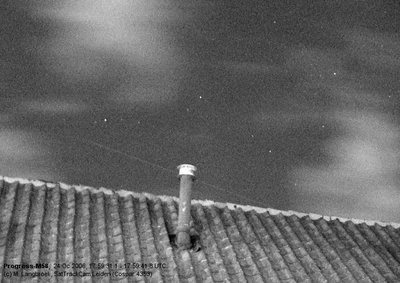
Yesterday evening I had dinner with Frans Rietmeijer, one of the Stardust scientists and an authority on IDP's. He is a personal friend and was in Holland for a.o. a Workshop. Over an Indonesian-Dutch "Rice table" he told me some interesting things about the preliminary mission results.
I observed it this evening under far from ideal circumstances: at an elevation of only 30-35 degrees, and seen through a hole in flying cloud cover, it crossed Aquila around 17:59:30 UTC just before it went into eclipse. It was very fast, at a steady magnitude +1.5.
Standing with my back pressed against the northern wall of the compound, looking south over the courtyard, I could see it grazing the roof of my house. Below is the photograph I obtained: maybe not quite spectacular, but I am glad I catched it at all. The start of the trail coincides with it clearing the roof edge! The image yielded 2 positions, with similar delta T (about +1.7s with regard to elsets then available).
Of course, a few minutes after this pass it was completely clear...
(click images to enlarge)


Yesterday evening I had dinner with Frans Rietmeijer, one of the Stardust scientists and an authority on IDP's. He is a personal friend and was in Holland for a.o. a Workshop. Over an Indonesian-Dutch "Rice table" he told me some interesting things about the preliminary mission results.
Tuesday 17 October 2006
Clear skies
The sky over SatTrackCam Leiden was very clear yesterday evening. Alas, there were little good satellite passes.
The only target captured was Lacrosse 4 (00-047A, #26473). The image yielded only one position, as the start point was obscured by a corner of a protruding part of the roof (see below).

The only target captured was Lacrosse 4 (00-047A, #26473). The image yielded only one position, as the start point was obscured by a corner of a protruding part of the roof (see below).
(click image to enlarge)

Sunday 15 October 2006
Hazy, Lacrosse 4 and Murphy
It cleared enough during the afternoon to make some tracking possible this evening. Yet conditions were far from good: much haze in the sky.
This was a bit bad day. I had stomach trouble, felt a bit moody, and Murphy struck with the first target of the evening.
That first target was Lacrosse 3 (97-064A, #25017). When I pressed the shutter release, the camera did not give the series of beeps it should give: I had forgotten to set the 10 second self-timer... The satellite trail is well-visible in the resulting exposure, but the timing of start and end are uncalibrated, so its useless for positions...
Next target half an hour later was Lacrosse 4 (00-047A, #26473) and there things went well. Got two good images as it passed through Draco into Umi. Four positions, showing the sat nicely on-time and on-track.
This was a bit bad day. I had stomach trouble, felt a bit moody, and Murphy struck with the first target of the evening.
That first target was Lacrosse 3 (97-064A, #25017). When I pressed the shutter release, the camera did not give the series of beeps it should give: I had forgotten to set the 10 second self-timer... The satellite trail is well-visible in the resulting exposure, but the timing of start and end are uncalibrated, so its useless for positions...
Next target half an hour later was Lacrosse 4 (00-047A, #26473) and there things went well. Got two good images as it passed through Draco into Umi. Four positions, showing the sat nicely on-time and on-track.
Saturday 14 October 2006
Warning about the orbit constellation plots
Hmmm, having played a bit more with it, it is clear that WinOrsa does not quite plot artificial earth satellites at the correct geographic subsatellite points.
The relative orbital constellation as such seems reasonably okay though. I think it models only using gravity (its software for modelling solar system object orbits after all) and not drag, hence the satellites get plotted at wrong positions in their orbits .
So be careful with the 3D plots I recently posted. The relative orbit orientations seem okay, but the absolute positions of the satellites not.
Note added 16/10: WinOrsa author Pasquale Tricarico today confirmed me that only gravity is modelled and not (yet) drag. This will hopefully be included in a future release. That would be cool, as the 3D graphic output of the software is great.
The relative orbital constellation as such seems reasonably okay though. I think it models only using gravity (its software for modelling solar system object orbits after all) and not drag, hence the satellites get plotted at wrong positions in their orbits .
So be careful with the 3D plots I recently posted. The relative orbit orientations seem okay, but the absolute positions of the satellites not.
Note added 16/10: WinOrsa author Pasquale Tricarico today confirmed me that only gravity is modelled and not (yet) drag. This will hopefully be included in a future release. That would be cool, as the 3D graphic output of the software is great.
Thursday 12 October 2006
Spysat orbital constellation plot: NOSS
Orbital constellation of the Naval Ocean Surveillance System (NOSS) satellites, duo's and trio's of satellites for tracking ocean shipping (more info here).
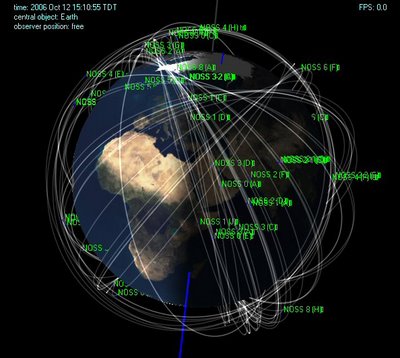

Wednesday 11 October 2006
Coincidence, or clever Korean timing?
Coincidence, or clever timing by the North Koreans? When North Korea conducted its alledged atomic bomb test last Monday at 01:36 UTC, it almost seems as if they waited untill the test area was just outside the footprint of the Japanese IGS 1B, detonating it within minutes of it passing by.
IGS 1B (03-009B, #27699) is a Japanese high resolution radar reconnaissance satellite, one of the primary purposes of which is to keep an eye on North Korea.
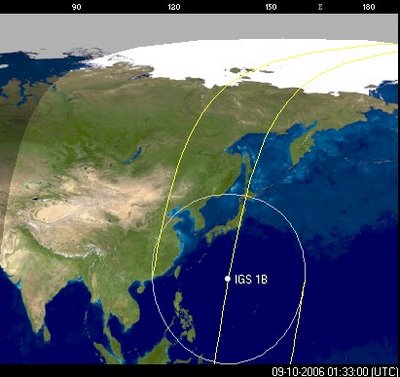
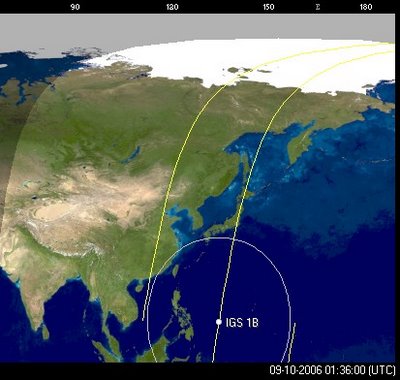
IGS 1B (03-009B, #27699) is a Japanese high resolution radar reconnaissance satellite, one of the primary purposes of which is to keep an eye on North Korea.


Tuesday 10 October 2006
Some spysat orbital constellation plots (KH-12 Keyhole, Lacrosse and IGS)
Plots of the orbit constellations of the American KH-12 Keyhole optical imaging satellites and Lacrosse (Onyx) synthetic aperture radar satellites, and the Japanese IGS optical and radar satellites.
(see here for details on how the plots were made and additional plots)
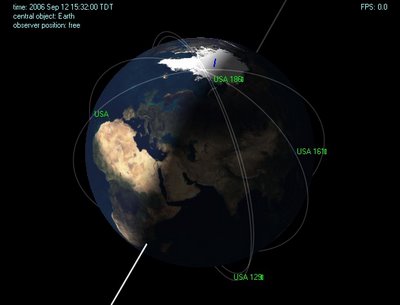
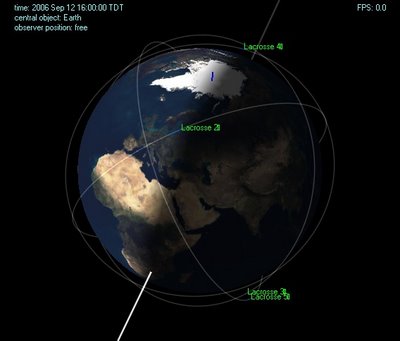
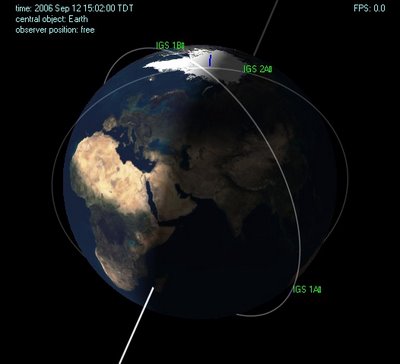
This plot shows how the IGS satellites keep an eye on North Korea:
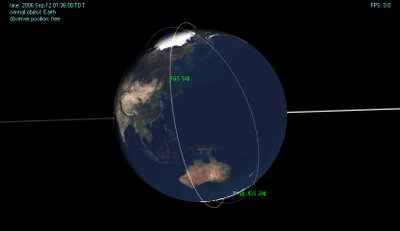
(see here for details on how the plots were made and additional plots)
(click images to enlarge)



This plot shows how the IGS satellites keep an eye on North Korea:
(click image to enlarge)

Picture fom last weekend
One of the pictures from last weekend, showing the trail of Lacrosse 5rk (05-016B, #28647), the still orbiting rocket stage of the Lacrosse 5 (05-016A) launch. The 'W' of Cassiopeia is well recognizable to the left of the trail (this, like all pictures on this blog, is a reduced resolution crop of part of the original image)
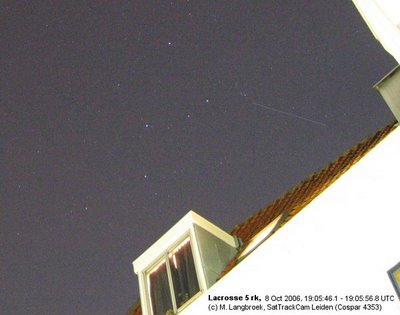
(click image to enlarge)

Sunday 8 October 2006
Unexpected clear sky: Lacrosse 3 & Lacrosse 5rk
It rather unexpectedly cleared in the evening. Good transparent sky.
A first pass (18:34 UTC) of Lacrosse 3 (97-064A, #25017) was captured but the trail too faint to measure. More luck during the 20:14 UTC pass, when it was bright just before going into eclipse. Two points, on-time but perhaps slightly off-track (0.05-0.07 deg) with regard to elset 06278.76700984.
Got two pictures of Lacrosse 5rk (05-016B, #28647), hence 4 points, it was bright, nice pass. It was some 0.4 sec late and on-track with regard to elset 06277.75736727.
With a temperature of only 11 C outside, it was chilly.
A first pass (18:34 UTC) of Lacrosse 3 (97-064A, #25017) was captured but the trail too faint to measure. More luck during the 20:14 UTC pass, when it was bright just before going into eclipse. Two points, on-time but perhaps slightly off-track (0.05-0.07 deg) with regard to elset 06278.76700984.
Got two pictures of Lacrosse 5rk (05-016B, #28647), hence 4 points, it was bright, nice pass. It was some 0.4 sec late and on-track with regard to elset 06277.75736727.
With a temperature of only 11 C outside, it was chilly.
Quite a lot....
Below are two plots I constructed showing the orbits of all 170 amateur tracked classified objects (operational and defunct satellites and rocket boosters) from Mike McCant's classfd.tle. Quite a lot, isn't it?
The images were made with Pasquale Tricarico's WinOrsa orbit software

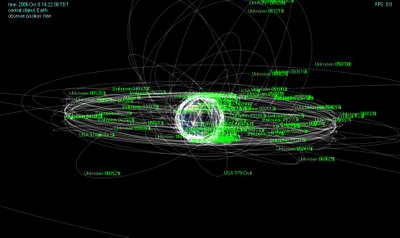
Update: some more plots of a few individual LEO sat orbit constellations here
The images were made with Pasquale Tricarico's WinOrsa orbit software
(click images to enlarge)


Update: some more plots of a few individual LEO sat orbit constellations here
Wednesday 4 October 2006
Bad luck
I was having bad luck this evening, quite some bad luck... First, cloud cover prevented me from imaging the early passes of Lacrosse 2 & 3 and Lacrosse 5Rk. Then it cleared, but just as I pressed the trigger button to image the next pass of Lacrosse 3, the camera shut itself off due to a battery problem. Ten minutes later, clouds won the race for a patch of clear skies with Lacrosse 5Rk by a margin of only a minute. Damn.
Saturday 30 September 2006
Lacrosse 3 & Lacrosse 5rk cruising up together
This evening I caught Lacrosse 3 (97-064A, #25017) and Lacrosse 5rk (05-016B, #28647), the rocket stage of the Lacrosse 5 launch, cruising up together in the sky in close proximity and same direction.
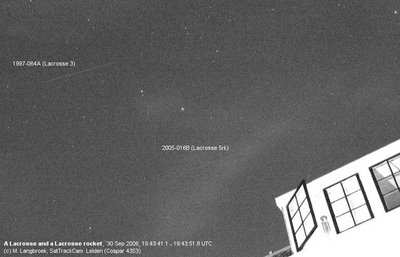
I managed to get only this one picture, as the battery of my camera was empty and hence my camera shut off after this image. Lacrosse 3 was about mag.+2, Lacrosse 5rk about +2.5.
There was some cirrus in the sky. Contrast has somewhat been enhanced in the posted image crop, to enhance the trails. Stars visible are mainly from Ursa minor and Draco, Polaris is in the upper right corner of the image.
97-064A was only 0.1s late relative to 6-day-old elements (elset 06267.82859916). 05-016B was 2.2s late relative to a week old elements (elset 06266.84118421).

(Click image for larger picture)
I managed to get only this one picture, as the battery of my camera was empty and hence my camera shut off after this image. Lacrosse 3 was about mag.+2, Lacrosse 5rk about +2.5.
There was some cirrus in the sky. Contrast has somewhat been enhanced in the posted image crop, to enhance the trails. Stars visible are mainly from Ursa minor and Draco, Polaris is in the upper right corner of the image.
97-064A was only 0.1s late relative to 6-day-old elements (elset 06267.82859916). 05-016B was 2.2s late relative to a week old elements (elset 06266.84118421).
Monday 25 September 2006
Illustrative diagrams

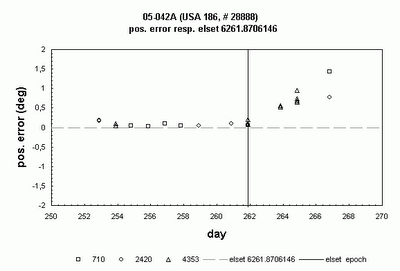
These two diagrams I prepared this weekend from recent observational data by stations Cospar 710, 2420 and me (4353) on KH-12 USA 186 (05-042A, #28888). They are compared to Mike's orbit elset 6261.8706146.
It very graphically demostrates the need for continuous orbital updates using our tracking data. As can be seen, data start to deviate quickly, due to orbital perturbations of the satellite, past the epoch date. Within 5 days after the elset epoch the satellite passes already 3 second early, a good degree off in position. This is why there is a continuous need for new tracking data.
Sunday 24 September 2006
Lacrosse 2
A second front passed yesterday, bringing a few raindrops in the morning. Around dusk it cleared for a while, but the sky remained very hazy. Nevertheless managed to image Lacrosse 2 (91-017A, # 21147). It was only 0.1s early and on-track, no surprises. A quickly deteriorating sky prevented other tracking attempts.
Friday 22 September 2006
USA 186 Flare Galore
Yesterday evening at the 20:44 UTC pass I was treated to two nice flares by KH-12 Keyhole USA 186 (2005-042A, #28888). Both flares happened while the camera was open (on two consecutive images). The second flare at 20:44:43 +/- 2s UTC amidst the stars of Ursa minor was brilliant, reached magnitude -2 and took over 10 seconds. The result was the fine photograph below:

The earlier flare ( a glint rather) was near the zenith and a short one, reaching magnitude +1 at 20:43:46 +/-2s UTC with a duration of less than a second.
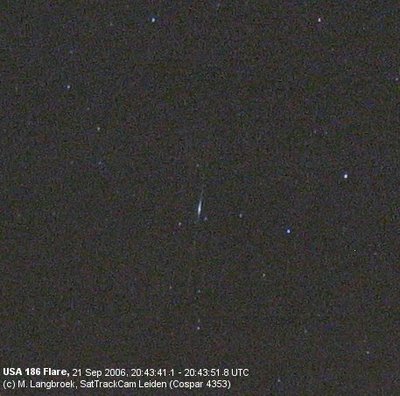
The positions obtained from the photographs suggest USA 186 (05-042A) appeared 1.8 sec early and 0.06 deg off-track relative to elset 06261.87061463.
I almost lost these two observations! I was busy with answering fireball reports pouring in on a bright almost-daylight fireball that appeared at 17:35 UTC and in doing so lost track on the time. So at 20:42 UTC I suddenly realised a USA 186 pass was imminent at 20:44 UTC! I jammed open the window, slammed the camera tripod on the courtyard, slammed the camera n it and got two very lucky shots...!
I have two older observation runs to report as well.
On Sept 20 I catched a faint trail of USA 186, as well as a bright trail of Lacrossse 2 (1991-017A, #21147).
On Sept 18th I observed two other short glints of USA 186, one of which was photographed:
* 21:10:12 ± 2s UTC very short, mag. -1. Caught on photo, flare appears near-stellar
* 21:10:35 ± 2s UTC again very short, mag. +0.5
On the photograph with the 21:10:12 UTC flare, the trail is very faint pre- and post-flare. I obtained one position (endpoint of the trail seemed defined enough to measure).

(click image for larger version)
The earlier flare ( a glint rather) was near the zenith and a short one, reaching magnitude +1 at 20:43:46 +/-2s UTC with a duration of less than a second.

(click image for larger version)
The positions obtained from the photographs suggest USA 186 (05-042A) appeared 1.8 sec early and 0.06 deg off-track relative to elset 06261.87061463.
I almost lost these two observations! I was busy with answering fireball reports pouring in on a bright almost-daylight fireball that appeared at 17:35 UTC and in doing so lost track on the time. So at 20:42 UTC I suddenly realised a USA 186 pass was imminent at 20:44 UTC! I jammed open the window, slammed the camera tripod on the courtyard, slammed the camera n it and got two very lucky shots...!
I have two older observation runs to report as well.
On Sept 20 I catched a faint trail of USA 186, as well as a bright trail of Lacrossse 2 (1991-017A, #21147).
On Sept 18th I observed two other short glints of USA 186, one of which was photographed:
* 21:10:12 ± 2s UTC very short, mag. -1. Caught on photo, flare appears near-stellar
* 21:10:35 ± 2s UTC again very short, mag. +0.5
On the photograph with the 21:10:12 UTC flare, the trail is very faint pre- and post-flare. I obtained one position (endpoint of the trail seemed defined enough to measure).
Monday 11 September 2006
Flare update and Cospar 4353 on Google Earth
Pierre observed in the same flarepath of USA 186 (05-042A) yesterday evening as the one that caused the flare I observed. From western France, he saw it flare about 40 seconds earlier than I did from the western Netherlands.
On an unrelated note: below is a Google Earth image where I have circled the location of SatTrackCam Leiden. The courtyard is well visible.
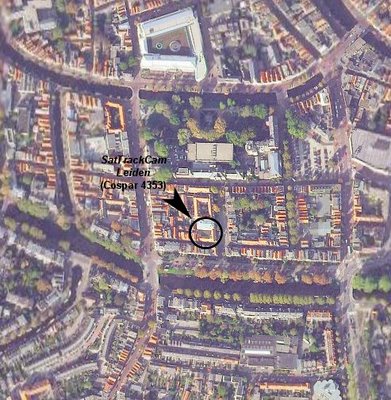
On an unrelated note: below is a Google Earth image where I have circled the location of SatTrackCam Leiden. The courtyard is well visible.

USA 186 flare, and is it manoeuvring?
KH-12 type Keyhole optical imaging reconnaisance sat USA 186 (05-042A, #28888) brightly flared to mag. -2 in the northwest at 21:13:06 ± 3s UTC. When I first saw it, looking up from triggering the 10 second camera selftimer, it was very bright, and it faded gradually as the camera opened (see image below). It was a very slow flare lasting tens of seconds, unlike the very brief glints I had observed so far from this satellite (e.g. report and photograph here).

It was as much as 9 seconds early and 0.10 deg off in cross-track with respect to 4 day old elset 06249.87384698, and 2.5s early with respect to Russel's observations 25 hours earlier: is it manoeuvring?
About an hour earlier I also captured another keyhole, USA 129 (96-072A, #24680). The trail was faint, the two obtained positions are about 1s early.

(click image for larger picture)
It was as much as 9 seconds early and 0.10 deg off in cross-track with respect to 4 day old elset 06249.87384698, and 2.5s early with respect to Russel's observations 25 hours earlier: is it manoeuvring?
About an hour earlier I also captured another keyhole, USA 129 (96-072A, #24680). The trail was faint, the two obtained positions are about 1s early.
Sunday 27 August 2006
Short observing session
After many days with heavy rainshowers, it cleared yesterday evening.
I did a short observation run: cut short alas by the return of clouds just before an IGS 1B zenith pass. I did manage to get data on Lacrosse 2 (91-017A),and observed two short bright glints by two Keyholes, USA 186 (05-042A) and USA 129 (96-072A). Lacrosse 2 appearred some 0.1s early.
2005-042A glinted to mag. 0 during less than a second at about 20:01:25 ± 5s UTC. 1996-072A did the same to mag 0 at 20:22:17 ± 3s UTC.
I captured both flares/glints on photograph, but in both cases only the very brief glints show up (almost star-like) and not the fainter rest of the trail, hence no useful positions could be derived from the images and they are not even worth posting here.
I did a short observation run: cut short alas by the return of clouds just before an IGS 1B zenith pass. I did manage to get data on Lacrosse 2 (91-017A),and observed two short bright glints by two Keyholes, USA 186 (05-042A) and USA 129 (96-072A). Lacrosse 2 appearred some 0.1s early.
2005-042A glinted to mag. 0 during less than a second at about 20:01:25 ± 5s UTC. 1996-072A did the same to mag 0 at 20:22:17 ± 3s UTC.
I captured both flares/glints on photograph, but in both cases only the very brief glints show up (almost star-like) and not the fainter rest of the trail, hence no useful positions could be derived from the images and they are not even worth posting here.
Thursday 24 August 2006
20% off on all Weapons of Mass Destruction!!!!
Okay, after Hezbollah visited my website yesterday, they seemed to have given a call to their benefactors to check things out. Because today I found these IP entries in my webstats:

Maybe I ought to start including some Google ads for Weapons of Mass Destruction on my webpage, it might perhaps bring me some revenues... :-p
PS: and welcome back, Cuba!

(Click image to enlarge)
Maybe I ought to start including some Google ads for Weapons of Mass Destruction on my webpage, it might perhaps bring me some revenues... :-p
PS: and welcome back, Cuba!
Wednesday 23 August 2006
Feind hort mit!
Uuhmmm, yeah....: if you suddenly see this kind of IP with this kind of search engine keywords appear in the webstats of your satelite tracking camera webpage, that gives you reasons to think, isn't it?
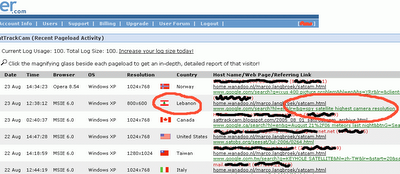
Maybe also the opportunity to say hi to the reader from Cuba that frequently visits... (come to think of it: he/she seems to be gone since Fidel is in hospital...)
* starts to scan the skies for black unmarked helicopters... *

(click image to enlarge)
Maybe also the opportunity to say hi to the reader from Cuba that frequently visits... (come to think of it: he/she seems to be gone since Fidel is in hospital...)
* starts to scan the skies for black unmarked helicopters... *
Saturday 12 August 2006
Slow Lacrosse 5 flare (belated post)
Due to circumstances, a quite belated report.
I observed a beautifull pass of Lacrosse 5 (2005-016A, #28646) one week ago, August 6-7. It was very bright, and showed a slow magnitude zero flare at (Aug 06) 23:15:25 ± 10s UTC.
For the part of the pass that I could observe (roughly from 30 deg altitude NW, where I first picked it up, to 40 deg altitude NE where it moved behind the building) it did not do its 'disappearance trick' this time.
I obtained 3 trail photographs during the pass. The positions indicate Lacrosse 5 was approoxmately 0.4 seconds late
A photograph of the very bright trail fading gradually some seconds after the brightness peak (photograph 2 in the series) can be seen here:
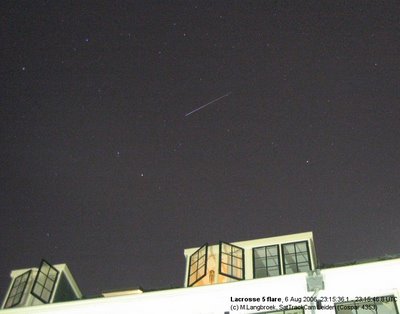
I observed a beautifull pass of Lacrosse 5 (2005-016A, #28646) one week ago, August 6-7. It was very bright, and showed a slow magnitude zero flare at (Aug 06) 23:15:25 ± 10s UTC.
For the part of the pass that I could observe (roughly from 30 deg altitude NW, where I first picked it up, to 40 deg altitude NE where it moved behind the building) it did not do its 'disappearance trick' this time.
I obtained 3 trail photographs during the pass. The positions indicate Lacrosse 5 was approoxmately 0.4 seconds late
A photograph of the very bright trail fading gradually some seconds after the brightness peak (photograph 2 in the series) can be seen here:

(Click on image for larger version)
Thursday 3 August 2006
Difficult Lacrosse 5 flare (?) observation
Tried to observe the 01:11:48 UTC predicted Lacrosse 5 (2005-016A, #28646) flare last night predicted for my location by Phillip Masding.
Observing conditions were very bad, as I had to watch the sat through broken cloud cover. I cannot 100% positively say I saw it flare in the sense of seing it rise and fall in brightness: all I can say is that it was very bright at the flare time, being about mag.-1 (when I first picked it up lower in the sky at 01:10:00 UTC, it was about mag. +1.5).
Photograph below (01:11:46.1 - 01:11:56.8 UTC). The photograph gives you a good idea of the difficult observing conditions.
It is overcast with heavy rainshowers here at the moment, so I am affraid this evenings possible flare is lost for me.

Observing conditions were very bad, as I had to watch the sat through broken cloud cover. I cannot 100% positively say I saw it flare in the sense of seing it rise and fall in brightness: all I can say is that it was very bright at the flare time, being about mag.-1 (when I first picked it up lower in the sky at 01:10:00 UTC, it was about mag. +1.5).
Photograph below (01:11:46.1 - 01:11:56.8 UTC). The photograph gives you a good idea of the difficult observing conditions.
It is overcast with heavy rainshowers here at the moment, so I am affraid this evenings possible flare is lost for me.

(click image for larger picture)
Tuesday 1 August 2006
Lacrosse 5: now you see it, now you don't....
Phillip Masding had predicted a possible Lacrosse 5 (2005-016A) flare for me for last night at 21:50:22 UTC:
Flare Results for Flight Mode YVV Panel Angle 33°
12. SAR MA 2.97104043228698 at 31/07/2006 21:51:22 Alt=74.2391395227923
However: it did not flare, but disappeared again instead....
I picked Lacrosse 5 up at about 21:50:00 UTC near Bootes/CrB. It was mag. +2.5 brightening to +2.0 in the next half minute or so.
Somewhere around 21:50:45 I started to look at my clock to trigger the camera countdown at 21:51:07 UTC. When I looked up again at 21:51:09 or so, it already was gone. It did not re-appear.
The photograph (21:51:18.1 to 21:51:28.8 UTC) shows no trail at all, meaning that at that time it must have been fainter than +3.5. Would it have been as bright as it was a 21:50:00 to 21:50:45 it would be visible on the image, and certainly if it subsequently would have flared.
There was some thin cirrus in the sky, but the area where it should have flared was clear and faint stars are visible on the image.
Flare Results for Flight Mode YVV Panel Angle 33°
12. SAR MA 2.97104043228698 at 31/07/2006 21:51:22 Alt=74.2391395227923
However: it did not flare, but disappeared again instead....
I picked Lacrosse 5 up at about 21:50:00 UTC near Bootes/CrB. It was mag. +2.5 brightening to +2.0 in the next half minute or so.
Somewhere around 21:50:45 I started to look at my clock to trigger the camera countdown at 21:51:07 UTC. When I looked up again at 21:51:09 or so, it already was gone. It did not re-appear.
The photograph (21:51:18.1 to 21:51:28.8 UTC) shows no trail at all, meaning that at that time it must have been fainter than +3.5. Would it have been as bright as it was a 21:50:00 to 21:50:45 it would be visible on the image, and certainly if it subsequently would have flared.
There was some thin cirrus in the sky, but the area where it should have flared was clear and faint stars are visible on the image.
Saturday 29 July 2006
Two classified SAR birds in one image

(click for larger image)
Under far from optimal conditions I was able to capture the trails of two
classified Radar birds on one image, only a few degrees apart: IGS 1B (2003-009B, #27699) and Lacrosse 4 (2000-047A, #26473).
This is a crop of the original image, reduced in resolution. In the center of
the image is Corona Borealis.
As the sky was very hazy the original colour image was quite fogged, so I
transferred it to B/W and then played with the contrast a bit to make the trails
stand out better.
It became overcast shortly after so no chance to capture the odd bird Lacrosse 5
again. My photograph of the 26th sparked a whole series of communications about the cause of the "disappearance trick" and the configuration of the Lacrosses in general.
Thursday 27 July 2006
Lacrosse' 5 odd behaviour
Last night Lacrosse 5 (2005-016A, #28646) performed its amazing "disappearance trick" again, just as it did in March. This time however, it did while the camera was open: it was caught in the act of disappearing:
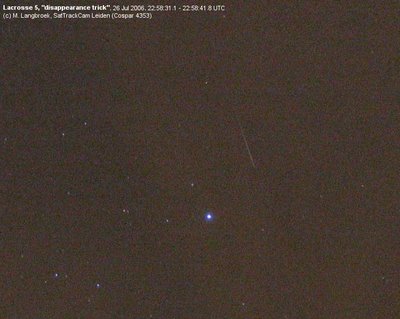
Movement is from bottom to top here. Lyra is well recognizable. You can see the trail quickly fading out (it takes maybe 2-3 seconds in total). In fact, the trail should end between 13 & 16 Lyr (the two stars above the trail) on this 10.7 s exposure. Also note that the satellite was nowhere near shadow entry at this time.
As Ted Molczan and Allan Thomson have stated, the suggestion is that a dark "something", perhaps an antenae panel, blocks view of the main body. At any rate, this behaviour is peculiar to Lacrosse 5 and not shown by Lacrosse 2, 3 & 4. In fact, Lacrosse 5 deviates in a number of things:
* it is brighter (visually and photographically);
* instead of red-orange it is yellow in colour;
* the other Lacrosse-birds don't do the "disappearance-trick"
(instead, they show short flares)
To which Ted Molczan added:
* It is also the first not to employ a frozen orbit.
Other observations I did the past days, observations which due to various reasons I did not come to discuss here yet were:
- Lacrosse 4 on July 23rd
- IGS 1B and Lacrosse 3 & 4 on July 21st
- Lacrosse 3 on July 18th

(click image for enlargement)
Movement is from bottom to top here. Lyra is well recognizable. You can see the trail quickly fading out (it takes maybe 2-3 seconds in total). In fact, the trail should end between 13 & 16 Lyr (the two stars above the trail) on this 10.7 s exposure. Also note that the satellite was nowhere near shadow entry at this time.
As Ted Molczan and Allan Thomson have stated, the suggestion is that a dark "something", perhaps an antenae panel, blocks view of the main body. At any rate, this behaviour is peculiar to Lacrosse 5 and not shown by Lacrosse 2, 3 & 4. In fact, Lacrosse 5 deviates in a number of things:
* it is brighter (visually and photographically);
* instead of red-orange it is yellow in colour;
* the other Lacrosse-birds don't do the "disappearance-trick"
(instead, they show short flares)
To which Ted Molczan added:
* It is also the first not to employ a frozen orbit.
Other observations I did the past days, observations which due to various reasons I did not come to discuss here yet were:
- Lacrosse 4 on July 23rd
- IGS 1B and Lacrosse 3 & 4 on July 21st
- Lacrosse 3 on July 18th
Monday 17 July 2006
Clear skies continue
Clear skies continue, so last night I have been tracking again. For the first time in several weeks a Keyhole let itself be imaged again: USA 161 (2001-044A)was imaged as a very faint trail. No flares this time. Lacrosse 3 (1997-064A) made a nice bright crisp trail, and I captured IGS 1B (2003-009B) while it was cleearing the roof.
Staying up late (untill after 2 am) is taking its toll now though, so the next days I might opt for sleep instead.
Staying up late (untill after 2 am) is taking its toll now though, so the next days I might opt for sleep instead.
Sunday 16 July 2006
NLC's and satellites
Last Friday evening saw a major display of Noctilucent Clouds here. Casper ter Kuiile sent out the first alert around 23:00 CEST through our DMS Alert Network. I made a short stroll throught the city untill I found a spot with visibility low enough down to the horizon. Nice, I hadn't seen the eery blue glow of NLC's for a few years.
Later that night I captured Lacrosse 3 and Lacrosse 5 Rk.
Later that night I captured Lacrosse 3 and Lacrosse 5 Rk.
Friday 14 July 2006
A nice and predicted Lacrosse 3 flare
Philip Masding predicted a flare of Lacrosse 3 (25017, 97-064A) for my site for this night (jul13-14), 00:22:22 UTC.
I watched Lacrosse slowly flare to mag. 0 at 00:22:27 +/- 1s UTC. So his prediction was correct by an error of only 5 seconds!
Below is the image I shot of the flare (click image for larger size). Earlierr this night I saw USA 161 briefly flare too.
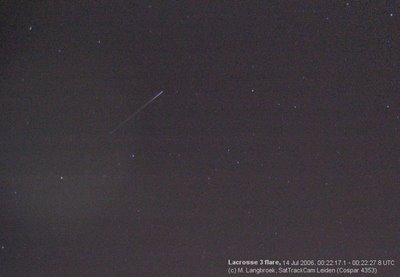
I watched Lacrosse slowly flare to mag. 0 at 00:22:27 +/- 1s UTC. So his prediction was correct by an error of only 5 seconds!
Below is the image I shot of the flare (click image for larger size). Earlierr this night I saw USA 161 briefly flare too.

Thursday 13 July 2006
Tracking again, and imaging nightfall in time-lapse
After a period with clouded evening skies and/or no opportunity to track, last week saw some opportunities again. Yesterday and the day before I obtained images on Lacrosse 3, as well as IGS 1B, the latter having manouvred acoording to Pierre. I hope the good weather prevails, because Philip Mading mailed me a whole list with Lacrosse 3 flare predictions which I want to put to the test.
Yesterday night while tired and typing in the designations, I made a typo in the Cospar code for Lacrosse 3, which was diligently spotted by Russell.
Meanwhile I am still hooked by the time-lapse photography bug. Below is a movie showing nightfall over Cospar 4353, shot yesterday evening. Compressed into an 48 second movie is 4 hours of real time, starting 2.5 hours before sunset and ending 1.5 after sunset. The movie was made from 711 individual photographs.
Yesterday night while tired and typing in the designations, I made a typo in the Cospar code for Lacrosse 3, which was diligently spotted by Russell.
Meanwhile I am still hooked by the time-lapse photography bug. Below is a movie showing nightfall over Cospar 4353, shot yesterday evening. Compressed into an 48 second movie is 4 hours of real time, starting 2.5 hours before sunset and ending 1.5 after sunset. The movie was made from 711 individual photographs.
Sunday 9 July 2006
Another Time-Lapse movie
Another time-lapse movie which I made this afternoon. It is 1.5 hours (264 photographs) of moving cloud-scape shot between 13:10 and 14:40 CEST, compressed into a 18 second movie. Good Bye Blue Sky...see the dark clouds move in again... First experiment with adding some music too.
And obviously, with this type a dynamic atmosphere, there is little satellite tracking to be done..
And obviously, with this type a dynamic atmosphere, there is little satellite tracking to be done..
Saturday 8 July 2006
Time-lapse of frontal cloud cover arriving
I am experimenting a bit with time-lapse photography. Thanks to the digital revolution, this is quite do-able nowadays with the help of a digital camera, a lap-top (or pc), and some freeware and shareware available on the web.
Below 18 second .avi movie was made with my Canon Digital Ixus 400 hooked up to my lap-top, which thus controlled its operation. 181 pictures were taken over a timespan of 1.5 hours (so: one each 0.5 minute).
The attempt initially was to capture the clour-play of sunset on the high altitude cirrus clouds. But right after I started the series, a frontal low cloud cover came in.
Below 18 second .avi movie was made with my Canon Digital Ixus 400 hooked up to my lap-top, which thus controlled its operation. 181 pictures were taken over a timespan of 1.5 hours (so: one each 0.5 minute).
The attempt initially was to capture the clour-play of sunset on the high altitude cirrus clouds. But right after I started the series, a frontal low cloud cover came in.
Wednesday 5 July 2006
Impressive clouds...
A thunderstorm developed here this morning. A few hours later, the clouds below appeared over the town, signifying the very unstable air. This picture was shot by me today (5 July 2006) at 13:00 CEST (11:00 UTC) from the Beestenmarkt, Leiden. I have tried to identify the type, and the best I can come up with is Stratocumulus opacus mamma.
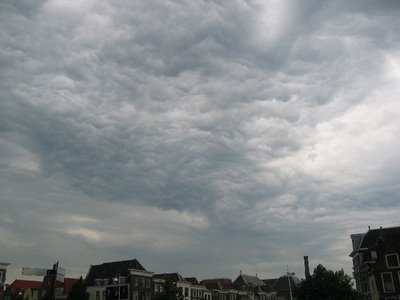

Sunday 25 June 2006
Progress M-57 observed
The Progress M-57 supply space-ship was launched from Russia in the afternoon of the 24th, heading to the ISS.
Based on a predicted TLE by Bob Christy I managed to see it passing near the zenith in bright twilight at 21:14 UTC. It was about mag. +1, easily visible with the naked eye notwithstanding the twilight, and steady. It was moving very fast, due to its still low altitude. It was very nice to see.
In a communication with Leo Barhorst, who observed the spaceship and its rocket on the same pass, it was resolved that the object I saw was indeed the Progress and not the rocket, as Leo observed the rocket to be flashing while Progress was steady (as was the object I saw).
Because of the still bright sky, no photography was attempted.
Based on a predicted TLE by Bob Christy I managed to see it passing near the zenith in bright twilight at 21:14 UTC. It was about mag. +1, easily visible with the naked eye notwithstanding the twilight, and steady. It was moving very fast, due to its still low altitude. It was very nice to see.
In a communication with Leo Barhorst, who observed the spaceship and its rocket on the same pass, it was resolved that the object I saw was indeed the Progress and not the rocket, as Leo observed the rocket to be flashing while Progress was steady (as was the object I saw).
Because of the still bright sky, no photography was attempted.
Wednesday 21 June 2006
USA 161 flashing, Lacrosse 4 and a stray
A late report on the observations on the nigh of of June 19-20th. I was too tired yesterday to write an entry.
Highlight of the nigh was capturing Keyhole USA 161 (01-044A, #26934) while it was giving a series of very short bright mag. -2 flashes (at least 3 in about 2 minutes time). I captured two with the camera, the best of which is below (arrow points to flare which almost looks like a star, a faint trail can be seen to the upper right).
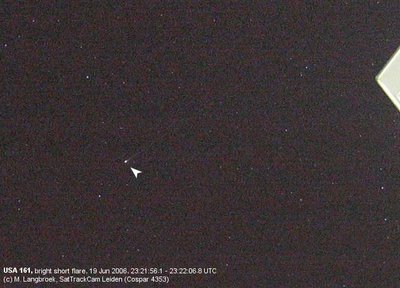
Above picture yielded two positions, indicating USA 161 was on-time but slightly off-track (0.05 deg in cross-track).
flash 1: 23:22:06 UTC ± 1 s
flash 2: 23:22:??
flash 3: 23:23:35 UTC ± 2s
I also captured Lacrosse 4 again, and a stray, which turned out to be Kosmos 1602 (84-105A). The observations on the latter suggests there might be a timing error in my Lacrosse 4 data of this night. The sat was on-track (cross-track error max. 0.01 deg).
The timings keep being the biggest bottle-neck. It will only be resolved if ever I come in the financial position again where I can allow myself a better camera that can be triggered directly from the lap-top.
Highlight of the nigh was capturing Keyhole USA 161 (01-044A, #26934) while it was giving a series of very short bright mag. -2 flashes (at least 3 in about 2 minutes time). I captured two with the camera, the best of which is below (arrow points to flare which almost looks like a star, a faint trail can be seen to the upper right).

Above picture yielded two positions, indicating USA 161 was on-time but slightly off-track (0.05 deg in cross-track).
flash 1: 23:22:06 UTC ± 1 s
flash 2: 23:22:??
flash 3: 23:23:35 UTC ± 2s
I also captured Lacrosse 4 again, and a stray, which turned out to be Kosmos 1602 (84-105A). The observations on the latter suggests there might be a timing error in my Lacrosse 4 data of this night. The sat was on-track (cross-track error max. 0.01 deg).
The timings keep being the biggest bottle-neck. It will only be resolved if ever I come in the financial position again where I can allow myself a better camera that can be triggered directly from the lap-top.
Sunday 18 June 2006
USA 116 keyhole flare
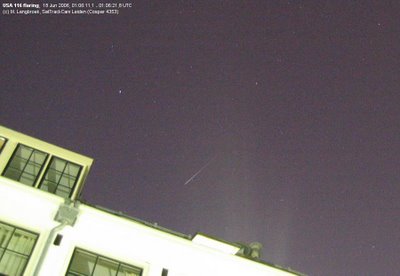
Last night at 1:06:25 UTC (3:06 am local time) I observed a nice mag. -2 flare of Keyhole USA 116 (1995-066A, #23728). The onset of the flare was captured by the camera, the image yielding two nice positions.
This was the first time I imaged USA 116. The obtained positions are on-track and at best some 0.1s early.
I also captured Lacrosse 4 (2000-047A), as I did a few nights earlier, on the 12th June. The June 12 data were "only"0.45s late relative to a 20-day old elset, and some 0.17 deg off-track in cross-track.
Last night's 2000-047A data are some 0.15s early, and again off track (about 0.12 deg. in cross-track) relative to an updated 3-day old elset (elset 06165.01332539).
Sunday 11 June 2006
Catched a mag -1.5 Lacrosse 2 flare
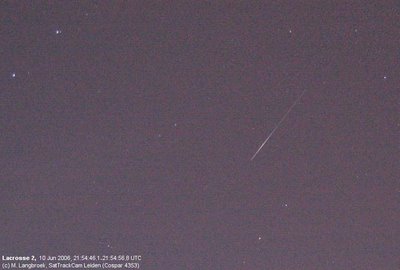
The haze in the sky was less last night than previous nights. At 21:54:48 UTC I cached Lacrosse 2 (1991-017A, #21147) flaring too about mag. -1.5, while the camera was open. I produced the very nice pcture above, as well as some good positional results. Satellite movement is from lower left to upper right.
The trail is very well defined on the image, while overall star positional inaccuuracy is only 22". Relative to Mike's 1-day old elset 06159.92449946, delta T is +0.02 resp. -0.01 seconds. The crosstrack error is 0.05 resp. 0.06 degrees. This is larger than usual and given the very fine results overall, this cross-track deviation must be a real deviation and not a measurement error imho.
Lacrosse 2
1 21147U 91017A 06159.92449946 0.00000080 00000-0 11747-4 0 06
2 21147 67.9874 90.2300 0005500 236.6210 123.3790 14.75395581 05
LAST OB : 161
STA____ AZ____EL_____ASP____XTRK__deltaT Perr
4353___348.35__73.19__76.50__0.05__0.02___0.050
4353_____3.37__78.76__82.47__0.06_-0.01___0.057
sum 0.05354
Friday 26 May 2006
Clear skies at last...with a -2 Lacrosse 5 flare
A clear evening again after many days with rain and hailstones. Slight haze but otherwise good, +10 C. I managed to capture IGS 1B (03-009B) and Lacrosse 5 (05-016A).
Lacrosse 5 (05-016A) briefly and unexpectedly flared to mag -2.0 at 22:02:20 UTC (+/- 10s) while I was preparing the camera. It made a distinctly yellow impression in colour. Food for Philip!
03-009B was 2.8s early relative to elset 06135.93706251, while 05-016A was 0.4s late relative to elset 06141.91063216
At this moment, the sky is overcast again.
Lacrosse 5 (05-016A) briefly and unexpectedly flared to mag -2.0 at 22:02:20 UTC (+/- 10s) while I was preparing the camera. It made a distinctly yellow impression in colour. Food for Philip!
03-009B was 2.8s early relative to elset 06135.93706251, while 05-016A was 0.4s late relative to elset 06141.91063216
At this moment, the sky is overcast again.
Wednesday 24 May 2006
The weather, weather data for Cospar 4353, and the Navy Googling for USA 129
Weather is still bad here. Yesterday afternoon it looked like I could do some observations, as it nearly completely cleared, but in the evening fields of cumulus came in again. At this moment, it is raining and we even had hailstones today. The bad weather the past week means I could not test Phil Masding's predictions for several Lacrosse 5 flares by observing them.
On another note: last weekend saw my weather station becoming operational. I purchased a small electronic (radiographic) weather station through ebay recently. After some sawing, hammering and painting activities resulting in a 1.5 meter pole with an half-open small casing on it, the sensor is now on the courtyard and sending its temperature records to the receiver in my home. A daily report of measured maximum- and minimum temperatures and air pressure at Cospar 4353 can now be found here.
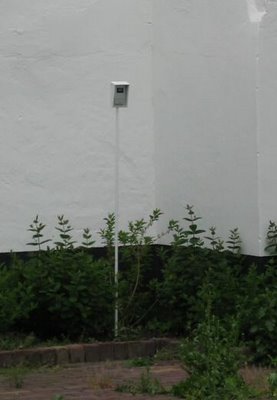
I had the US Navy visiting my webpage today. Someone there Googled for "USA 129". I have more military visits every now and then.
24/05/2006 17:30 CEST temp. 10.1 C, air presssure 1016 hPa
On another note: last weekend saw my weather station becoming operational. I purchased a small electronic (radiographic) weather station through ebay recently. After some sawing, hammering and painting activities resulting in a 1.5 meter pole with an half-open small casing on it, the sensor is now on the courtyard and sending its temperature records to the receiver in my home. A daily report of measured maximum- and minimum temperatures and air pressure at Cospar 4353 can now be found here.

I had the US Navy visiting my webpage today. Someone there Googled for "USA 129". I have more military visits every now and then.
24/05/2006 17:30 CEST temp. 10.1 C, air presssure 1016 hPa
Sunday 21 May 2006
Meeting other satellite observers
Yesterday I travelled to Belgium to meet some other satellite observers out of the BWGS at the home of Bram Dorreman. The meeting was as well a BWGS meeting, a birthday meeting for Bram Dorreman, and a meeting to celebrate his 40th anniversary as a satellite observer.
Leo picked me up by car at Vleuten and we then continued to fetch Wim and a Belgian lady Marieke. Other joining at Bram's house were Tristan and Kurt. The meeting was very pleasant and informal, we were cared for very well in terms of drinks and food by Bram and his wife. For me, this was the first time I met other satellite observers except of Bram.
Wim brought some bulletins out of the "old box" with him. Kurt demonstrated the latest development of his internet PPAS database. Bram brought us back to the early days, by demonstrating the 'ancient' and time consuming graphic technique for predicting satellite passes of yesteryear. Ah, so much has changed...
It was a fun meeting.
The weather is very bad here the past week. Heavy rain showers and thick cloud cover.
Leo picked me up by car at Vleuten and we then continued to fetch Wim and a Belgian lady Marieke. Other joining at Bram's house were Tristan and Kurt. The meeting was very pleasant and informal, we were cared for very well in terms of drinks and food by Bram and his wife. For me, this was the first time I met other satellite observers except of Bram.
Wim brought some bulletins out of the "old box" with him. Kurt demonstrated the latest development of his internet PPAS database. Bram brought us back to the early days, by demonstrating the 'ancient' and time consuming graphic technique for predicting satellite passes of yesteryear. Ah, so much has changed...
It was a fun meeting.
The weather is very bad here the past week. Heavy rain showers and thick cloud cover.
Wednesday 10 May 2006
Yesterdays Lacrosse 3 data
Russell Eberst reported data for Lacrosse 3 (97-064A) from last night as well, from a later pass. Our results quite agree:
STA___XTRK___deltaT___Perr
4353___0.04___-0.83___0.450
4353___0.02___-0.74___0.416
2420___0.02___-0.86___0.448
(STA = station, with 2420 being Russell; XTRK = cross-track error in degrees; deltaT = timing error in seconds, with negative meaning 'early'; Perr = positional error in degrees)
Relative to elset 06125.89779354, the satellite was some 0.8 seconds early.
STA___XTRK___deltaT___Perr
4353___0.04___-0.83___0.450
4353___0.02___-0.74___0.416
2420___0.02___-0.86___0.448
(STA = station, with 2420 being Russell; XTRK = cross-track error in degrees; deltaT = timing error in seconds, with negative meaning 'early'; Perr = positional error in degrees)
Relative to elset 06125.89779354, the satellite was some 0.8 seconds early.
Lacrosses and IGS 1B, and veil clouds
Summer has arrived: it is very sunny the past week, and I finally can leave my jacket at home and walk about in shorts and shirt, even observe in a T-shirt.
Nevertheless, sky conditions are not optimal. There is a thin veil in the skies, which in an urban environment like Leiden (and with moonlight now entering as well) is deadly to photographic observations. This was shown again last night: sat passes that were visible with the naked eye, drowned in the background fog on the photographic image. So I have seen Lacrosse 2, Lacrosse 3 and IGS 1B, but can only present positions for Lacrosse 3 as the other images did not yield measurable trails. The result on Lacrosse 3 was obtained in strong twilight before the thin veil clouds arrived. The image too is fogged, by twilight, but did yield a measurable trail and enough stars so I measured it and reported it.
Nevertheless, sky conditions are not optimal. There is a thin veil in the skies, which in an urban environment like Leiden (and with moonlight now entering as well) is deadly to photographic observations. This was shown again last night: sat passes that were visible with the naked eye, drowned in the background fog on the photographic image. So I have seen Lacrosse 2, Lacrosse 3 and IGS 1B, but can only present positions for Lacrosse 3 as the other images did not yield measurable trails. The result on Lacrosse 3 was obtained in strong twilight before the thin veil clouds arrived. The image too is fogged, by twilight, but did yield a measurable trail and enough stars so I measured it and reported it.
Thursday 4 May 2006
USA 129 under very bad conditions
Just when I was about to start my observing activities in late dusk yesterday evening, a thin motled cloud cover came in.
Much to my surprise, I did manage to get some results on USA 129 (96-072A) . The trail is visible through the cloud cover. Below a (reduced quality) shot of the Astrorecord screen: negative for clarity, and some image contrast enhancement has been performed before loading the image into Astrorecord.
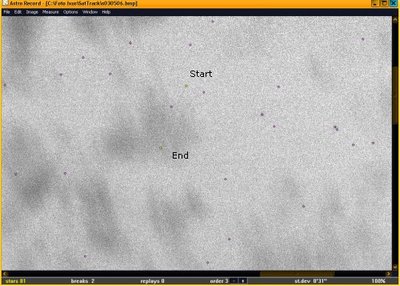
As can be seen, not quite an ideal catch! Normally I would not have reported data from such a marginal cloud-interfered trail. Yet in this case I did do because I hoped they migth be of help to analysts and Bjorn Gimle after his post here.
Much to my surprise, I did manage to get some results on USA 129 (96-072A) . The trail is visible through the cloud cover. Below a (reduced quality) shot of the Astrorecord screen: negative for clarity, and some image contrast enhancement has been performed before loading the image into Astrorecord.

(click image for larger picure)
As can be seen, not quite an ideal catch! Normally I would not have reported data from such a marginal cloud-interfered trail. Yet in this case I did do because I hoped they migth be of help to analysts and Bjorn Gimle after his post here.
Subscribe to:
Posts (Atom)
